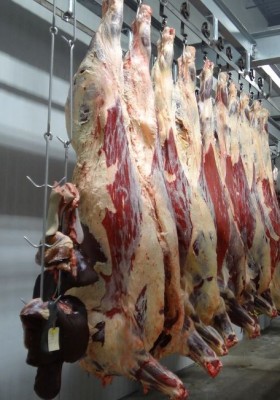A Glimmer Of Hope for Beef Producers
Amy Barkley, Team Leader & Livestock Specialist
Southwest New York Dairy, Livestock and Field Crops Program

Signs of recovery in beef packing…but how fast?
Derrell S. Peel, Oklahoma State University Extension Livestock Marketing Specialist
May 11, 2020
COVID-19 began impacting workers at beef packing plants in early April. In the last five weeks,
cattle slaughter decreased by an average of 27 percent year over year. This compares to the
previous five weeks in March, when cattle slaughter averaged 5.5 percent higher than year ago
levels. The impacts got progressively worse for four weeks with weekly slaughter dropping by
17.1 percent the week of April 11 to a decrease of 36.8 percent year over year in the week ending
May 2.
There is glimmer of hope, however. Last week estimated cattle slaughter was 452,000 head, still
down 32.2 percent year over year, but up 6.4 percent from the prior week. This hopefully
indicates the beginning of recovery of packing capacity in the coming weeks. Risks remain
however and it is not clear how fast packing plant capacity will recover. New safety measures
and work protocols likely mean that effective maximum capacity in beef packing plants will be
reduced compared to pre-COVID-19 levels.
It will likely take many weeks for slaughter rates to catch up with the growing backlog of fed
cattle and get the industry current once again. Meantime, all sectors of the industry are
responding to the need to slow cattle down and hold them longer in a variety of production
settings before proceeding to finish in feedlots. Fed cattle weights are increasing and pushing
carcass weights higher counter-seasonally. The latest actual weekly slaughter shows steer carcass
weights at 891 pounds, higher than the three prior weeks and up 37 pounds from the same period
last year. Heifer carcasses are currently 24 pounds heavier year over year. Steer and heifer
carcass weights typically reach a seasonal low in late May.
Beef production dropped sharply in April resulting in some shortages of fresh beef in retail
grocery stores and restaurants. In the five weeks ending May 9, total beef production was down
nearly 690 million pounds year over year. In the worst week ending May 2, estimated total beef
production was 347.1 million pounds, down 190.5 million pounds from the same week last
year. Estimated beef production last week was down 31 percent year over year but was up 5.9
percent from the prior week, reflecting the slight increase in cattle slaughter last week.
Total 2020 beef production forecasts have only been slightly reduced from previous projections
and are still at or near a record level of 27.2 billion pounds. However, the timing during the year
is drastically altered with second quarter beef production forecast down 13.3 percent year over
year. Beef production will be pushed into the third quarter, which is forecast to be up 5.4 percent
compared to last year. Fourth quarter beef production is currently forecast to be just slightly
higher year over year.
---
SWNY AND NY STATE REPORT:
Locally, auction prices are up, with moderate demand. Last week's auction reports (week of May 4th) showed that lean/boner cows are up $5-$10 at one regional auction and breaker/boner cows sold for $7 - $13 higher at the other. Although leaner cows were also up $5 - $7, getting some extra flesh on those cows is resulting in higher prices, around $41 - $60 vs the $29 - $50 for their leaner counterparts. Since the low on April 2, cow prices have increased by 12.2%. Choice and Prime steers sold for $103 - $107.5. Feeder steers under 600 lbs sold for $7 higher this week, with feeder heifers selling $5 - $10 higher. Full auction reports can be found on the USDA website: https://www.ams.usda.gov/market-news/feeder-and-replacement-cattle-auctions#NewYork
Although the status of Cargill remains the same, JBS is now buying both cows and fed cattle. At this time, they are processing between 1,600 - 1,700 head/day, with plans to soon increase to 2,100 - 2,200 head/day.
Upcoming Events
Boots in the Barn: Cornell Dairy Research Updates
January 13, 2026
January 20, 2026
January 27, 2026
February 3, 2026
February 10, 2026
February 17, 2026
February 24, 2026
Join us for some or all!
Advanced Hoof Health Program
January 15, 2026
Belfast, NY
Who should attend?
- Professional hoof trimmers
- Dairy farm owners or managers in charge of farm foot health
Topics include:
- How to Create a Strategic Trimming Program for your Dairy
- The Latest in Lameness Technology for the Dairy Industry
- Housing and Flooring Design: Its Role in Hoof Care
NY Pork Producers Connection Breakfast - Geneseo
January 17, 2026 : Pork Producers Connection Breakfast - Geneseo
Geneseo, NY
All pork producers are invited to join the New York Pork Producers for a free hot farmer's breakfast, at which they'll catch up on topics including the pork to dairy barn conversion series, NYPP digital campaigns, and 840-RFID tags.
Announcements
No announcements at this time.





